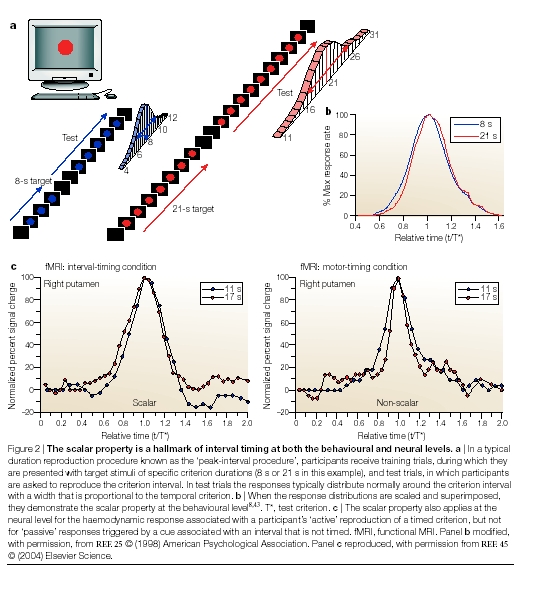The scalar property. Three types of
behavioural procedure have traditionally been used to investigate
interval timing in humans and other animals: estimation,
production and reproduction. In humans, the first two protocols
tend to rely on verbal instructions or responses, requiring the
participant to translate between performance and a verbal
representation of duration, which can lead to confounds. A more
reliable approach, which can be used equally well with a wide
variety of animal species, is to use a reproduction procedure,
in which the subject is presented with a given criterion duration
and then required to reproduce this duration (FIG. 2).
Typically, the participant’s responses follow a normal
distribution around the criterion duration, and the width of this
response distribution is proportional to the criterion
duration. The way in which the mean and standard deviation of
the response distribution covary is usually referred to as the
scalar property, and resembles WEBER’S LAW, which is obeyed
by most sensory dimensions. The scalar property applies not only to
behavioural responses, but also to neural activation as measured by
ensemble recording, or by the haemodynamic response to timed events
measured with fMRI

The theory of scalar timing, originally
proposed by Gibbon (1977) and developed later with other colleagues
(Gibbon, Church, & Meck, 1984) must surely rank as one of
the most successful recent imports from the animal to the human
psychological laboratories.
Scalar timing theory (Gibbon, 1977; Gibbon et
al., 1984) proposes that subjective time produced by the
underlying timing mechanism exhibits two properties. The first
of these is mean accuracy, the requirement
that mean estimates of some real time, t, should equal
t. The second requirement is the scalar
property itself, the requirement that standard deviations
of time estimates grow as a constant fraction of the mean. This
second property is
Scalar timing proposes that timed behaviour is
regulated by a complex underlying mechanism, discussed in more
detail later, involving an internal clock consisting of a
pacemaker and accumulator with a switch connecting them, as well as
memory and decision mechanisms, sometimes tested by
constructing a coeffcient of variation statistic
(standard deviation/ mean); thus the scalar property requires that
this coefficient of variation remain constant as the duration timed
changes.

